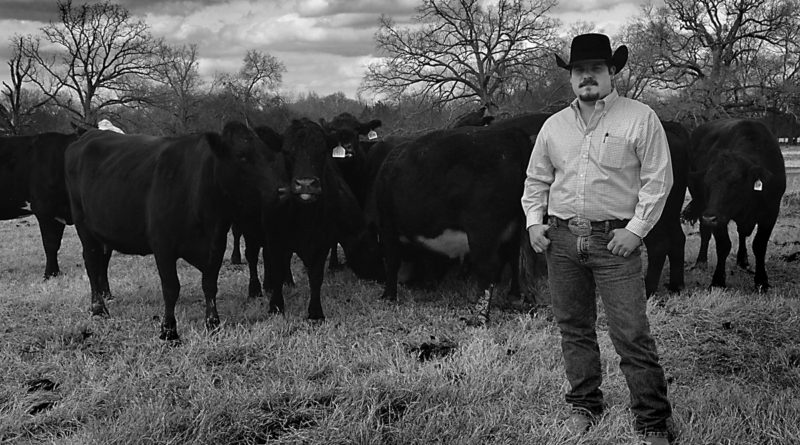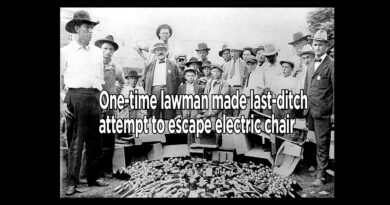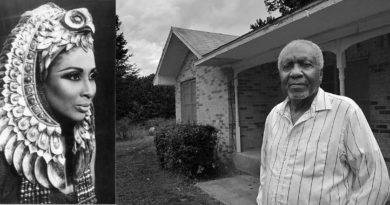Happy Hogs and Sugar Cane Sweeten Hess Family’s Place

Seventh generation on the family place, at 26 Ryan Hess has been around the block. He tried rodeoing after his baseball career fizzled before going into pipelining. He had a fling with TV on the Sportman’s channel, worked as a hunting guide and followed the oil patch before coming home.
The archaeological record figuring into the landscape of Gary and Bonnie Hess’s geodesic dome includes a Hog Joy Hog Licker. He found it on the back side of a pasture where there was a hog barn when he was growing up. A technological innovation for the day, it’s a cast iron cylinder intended to be powered by the tongue of a joyous hog spinning it through a gravity fed trough of syrup.
They grew sugar cane. During the tenant-farming era, it took every family on the place to make syrup. Women and children cut and trimmed the cane men hauled to the crusher.
“Syrup died out when women quit making biscuits and started buying sliced bread,” H.L. Hess II told Citizens Journal feature writer Mike Brooks in 1985. “You can’t spread syrup on light bread.” Born in 1918 in the same house his mother was born in 30 years earlier, Mr. Hess remembered as many as 20 tenant families working 2,500 acres.
A hundred years after his great grandfather arrived with a new bride, a feather mattress and a slave girl given as a wedding gift, Mr. Hess promoted the Texas dairy industry at annual conventions of The Flying Farmers.
Cotton prices crashed in the mid 20’s and the dairy industry boomed in Titus County and Hess Ranch for a while after the chamber of commerce in 1928-29 raised a $50,000 match for the Texas Milk Company. They built the milk plant by the Cotton Belt track on the southeast side of the Mt. Pleasant business district.
“When I was coming up the tenant farmers were converting to milking hands at the dairy,” said Hal Hess. Born in 1945, he’s one of five children of the fifth of the family’s seven generations at Old Union. The north side of the ranch fronts on U.S. 67 west of Cookville.
“I remember going up in daddy’s plane,” he said. “There was a landing strip west of us on the south side of the highway.”

At left, taking time to ski Colorado after some years on the Alaska Pipeline, on a snowy day on a remote trail high in the Rockies, Gary Hess came upon an aluminum geodesic dome dazzled bright in snowy sunlight, an image that stuck. So he built one on the Hess Ranch. Another ranching veteran, his younger brother Richard, (right) made himself a championship-caliber weekend motorcycle drag racer.
Incorporated in Oklahoma in 1945, the National Flying Farmers Association quarterly magazine staff caught up with H.L. at the 1949 Texas Flying Farmers Convention tour of the King Ranch before their foray into Mexico.
Farmer pilots used airplanes to land in fields and talk to harvesters, the magazine said. Sometimes farmer-ranchers set their airplanes down in pastures during calving time.
“It’s been used at least once to deliver a subpoena via air drop,” H.L. said. “There’s a real estate man over my way that got the idea of buying farms by picking them out from the air. He takes customers up to show a place.”
During H.L’s time, the Dallas Morning News and the Farm Journal wrote up the place. He was in his 80’s when the East Texas Journal caught up in 2003.
On a slow tour, crawling down the Hess Ranch Road that day in a pickup that hadn’t been registered in the current century, Richard Hess was pointing out hay barns, dairy facilities, hog barns, corn cribs and cabins slowly giving way to gravity.
“Uh-oh,” he said, glancing in the rear view mirror to catch flashing lights of a fast-closing sedan with a beagle dog hanging out the passenger window. Richard, the youngest of the fifth generation, coasted to a stop. No brakes.
“You fed yet?” H.L. checked his watch.
“Just fixing to.”
“Find out whose cow that is over yonder?”
“Not yet.”
“Well let’s get going. Then get over there on that fence at the Banks pasture. There’s still green grass over there.”
“Yes, sir.”
“Well,” H.L. adjourned the morning meeting, ordered his beagle back in the sedan, checked his watch. “I gotta get ready for lunch.”
“C’mon,” Richard said. “I’ll show you Perfecto’s Cabin.”

Eight years into business beginning in DeKalb, Hal and Mary Ann Hess got their big break in Mt. Pleasant when the ice storm of January, 1978 collapsed the roof on the store they’d opened 14 months earlier. It put them on the map because everybody in town heard about the community response mustering the volunteers and borrowing trucks to move the store in a day. More recently, Hess Furniture was named Southwest Region Dealer of the Year by the BrandSource buying group.
Before Dreamers, when Perfecto crossed the Rio Grande, he left his last name back in Mexico. Just Perfecto, like the cigar.
Nobody was certain Perfecto was his first name either. He nailed the mummified carcass of a dog to the wall by his door. It was still there in the 70’s, during high school years when Richard and friends camped at the cabin and experimented with explosives.
It was a phase.
His sister Margaret Ann was married and gone. Hal, a 1963 Mt. Pleasant All-District running back married Drum Major Mary Ann Stinson and left the farm in favor of the furniture business. H.L. “Hiller” III married Earnestine, built a house on the farm and went into sign painting. Money gushing from the Arctic oil boom lured Gary to Alaska.
For a time, tending the place fell to Richard and Ray Johnson, the last of the tenants born and died here. The patriarchs and matriarchs are buried on a rise above a bend in Evans Creek, not far from where the channel cuts into a coal seam on the Cox Family place through the woods to the east.
“That coal stinks when you burn it,” Gary Hess said, “sulfur.”
Gary and Larry Cox put a concrete picnic table on a slab of older concrete foundation where the coal mine was. (See story, page ___)
“We’ve always been told there was a steam engine mounted here,” Gary said, supposing it could have been used to turn a spool with cable pulling coal cars up the mine shafts. Some of the coal fired a brick kiln.
Good brick. Pieces found with straight edges sharp as the day a century back they were baked. A narrow-gauge spur rail led out to the Cotton Belt line that came through in 1880.
The area is patrolled by the Nodena Rangers.
“The way the name came about, Roger Harbour lived near and when he left for World War I they were still mining,” Mr. Hess said. “Mine and Larry’s daddy’s told his story about immigrants looking for work patting their bellys and saying ‘no dinner,’ which sounded like Nodena. Now me and Larry are telling it, so you know it’s true.”
He said his daddy said that the mines where gone by the years of the 30’s-era Great Depression and that tenants came and dismantled the miner’s abandoned houses for the lumber. He said his grandfather leased the land where tenants spent winter months sawing timber and splitting cord wood.
Before that, the tenants operated a commissary, cooking lunch for coal miners.
Nodena.
The county records went up in smoke when the courthouse burned in 1895. Family papers include some from Austin citing the Tennessee immigrant John Evans as a Titus County commissioner. Titus County was formed in 1846.
There’s a passed down story attributed to his wife, an account of their coming up from Marion County after riding into Texas through Jefferson. The point of her story was about being embarrassed because her horse threw her.
John Evans left for the Civil War and was taken prisoner. Family papers include his being given again his American citizenship by Union authorities manning the garrison at Jefferson after the war.
Their grand daughter Viva lost a young husband when a house fell on him. She lost their only child at four before she married Camp County Sheriff Hiller Ligon Hess.
The sixth generation skipped the ranch, moved on.
Cindy is the primary furniture buyer at Hess Furniture. Her brother Herbie presides over lawn and garden, appliances and electronics.
Herbie’s son, Ryan, planned on a career in baseball.
“I sure thought I was good enough,” said the recently returned seventh generation Hess Ranch Manager, who’s taken a circuitous route back. His third trip out the gate bull riding persuaded him to give up rodeo and leave home at 18 as a welder’s helper on a Florida pipeline. He pipelined in Tennessee, Iowa and Oklahoma.
Somewhere in there, his show biz career ended when his last of three appearances on the Sportsman’s Channel’s “Quack Shack” landed him work as a hunting guide with Rustin Morgan’s Dry Creek Outfitters in Wichita Falls.

On a day during the drilling boom, he was an operator building a well pad in Pecos where the desert view to empty horizons in all directions caused him to remember he loves home.
He grew up here, had friends with roping horses. That day in west Texas Ryan found appealing the thought of being horseback pushing cattle through forested bottoms and green fields.
“I like old school,” said the new Hess Ranch Manager.
At 26, he’s romantic. He also has a pickup with brakes, tool boxes and a feed hopper. Under the watchful eyes of the family elders, he’s picked 40 black heifers from a herd of mostly black crossbreds, a herd going back to the close of the Polled Hereford era in the 70’s.
“We’re going back with black bulls,” said Ryan, whose business strategies get channeled through advisers.
“Uncle Gary’s knows everything and Uncle Richard can fix anything,” Ryan said. “He’s the best doctor.
“They made it real easy to come back,” he said. “It seemed like I should.”





